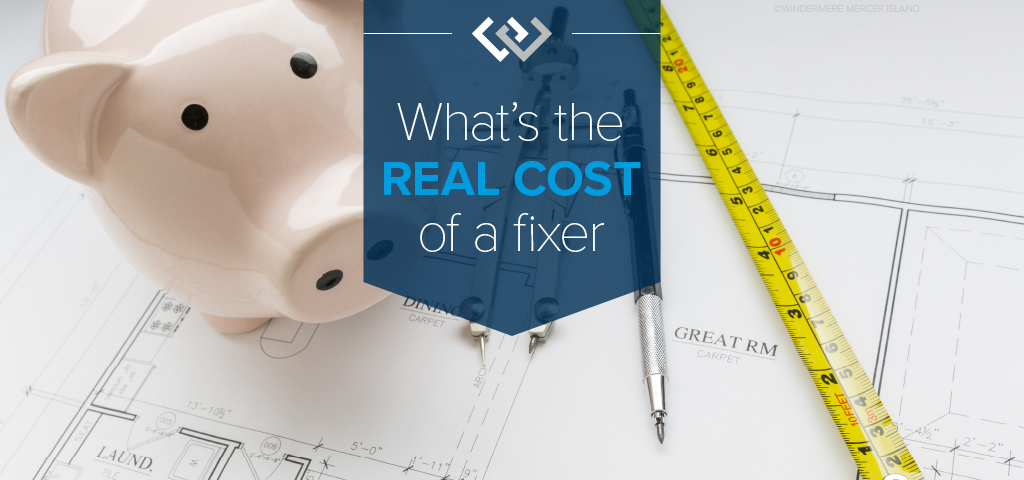Social Links Widget
Click here to edit the Social Media Links settings. This text will not be visible on the front end.
Assessing the Real Cost of a Fixer

It can be very compelling to find a home in a neighborhood you like that is bargain priced. But how do you know if it will be a good investment? The only certainty in a fixer project is that there will be a substantial amount of uncertainty and risk. There can be significant rewards too, which is why the call of a fixer is so loud for opportunistic buyers.
Here are a few guidelines to determine how much how much to offer and whether a fixer is the right house for you.
Step 1: Determine the initial scope of work
Make a list of the most obvious items to be addressed. Decide which items are within your skill set to accomplish yourself and which ones need to be contracted out. Spend some time calling contractors and researching each item to get a ballpark idea of the cost to complete—either the raw materials expense to DIY or the contractor’s price to do it for you. Calculate in an additional 20% for unexpected issues and cost overruns. Add these to a spreadsheet along with the time each project should take. Keep in mind this is an initial evaluation intended to be done before you invest too much time and money into negotiation or inspections.
It’s well worth spending a few minutes talking to the city or county building department to verify which work requires a permit and what the cost and process is before proceeding. Don’t forget to calculate in the cost of obtaining permits for electrical, plumbing, major remodel, or structural changes into your total budget. Getting permits can be time-consuming but doing work without a permit will ultimately create bigger problems when you go to sell because lenders and buyers will want verification the work was permitted and completed properly.
Step 2: Do a reality check
Do you have the readily available cash or an approved line of credit to fund this project plus any cost overruns? Do you have the skills and patience to manage or complete the renovation work? Are you able to fit the work itself or the oversight of contractors into your current life schedule without compromising your life values? Will the time and money you invest be worth it in the end product? Are you willing to live in a construction zone while work is being completed?
Don’t skip this step! The answer to these questions will be different for everyone. Some people take on a project because it pencils out without fully evaluating what the impact on their lifestyle will be. A savvy fixer buyer will go in with full awareness of what they are taking on and the project will be much smoother as a result.
Step 3: Determine your offer price and strategy (and max purchase price)
This is where your broker can be an invaluable resource. They can assess a home’s as-is market value and also its potential finished value. Calculating in the costs you identified in step one—including the 20% for unexpected issues and cost overruns—will give you an idea of your max purchase price. Don’t forget to consider expenses like the cost of living elsewhere during renovations, the inconvenience of living through a remodel, and the value of your time invested.
From there, your broker can evaluate market activity and present options for offer strategies, including an initial offer price. Your offer should always include an inspection and sewer scope or septic contingency unless you’ve completed them before making an offer. Here are additional contingencies you may want to include to protect you in your purchase.
Step 4: Don’t skimp on the inspection
Assuming you’ve decided that you and your pocketbook are up for the challenge, the next step is to hire the best inspector you can find to make a thorough assessment of the home. If there is obvious deferred maintenance you can see, there are likely to also be many other issues you can’t see. A good inspector will identify those and provide insight into the overall structural condition of the home. Well-built homes with “good bones” make much better rehab projects than homes of mediocre quality.
Don’t forget to scope the sewer line or evaluate the septic system. Both are potentially big-ticket items that don’t add any visible value to your finished product. If you are in an area that may have had oil heating at one time, also confirm there are no underground oil tanks remaining.
If major structural issues are identified or there are indications of problems that cannot be fully investigated, think seriously about proceeding without getting permission to have a structural engineer or general contractor investigate further.
Final thoughts
By thoroughly completing your due diligence, you can mitigate much of the risk associated with purchasing a fixer. Having remodeling skills or connections to outstanding contractors is critical. Lastly, if this is your first-time renovating a home, purchasing a home that is simply tired and dated rather than having significant deferred maintenance or structural issues will help you keep your project in the black.
Still have questions? Contact one of our knowledgeable brokers for assistance with how to purchase or determine the value of a potential fixer.
Find a Home | Sell Your Home | Property Research | Neighborhoods | Market Reports | Our Team
We earn the trust and loyalty of our brokers and clients by doing real estate exceptionally well. The leader in our market, we deliver client-focused service in an authentic, collaborative and transparent manner and with the unmatched knowledge and expertise that comes from decades of experience.
© Copyright 2020 Windermere Mercer Island.
Flip or Flop? Is That Gorgeous Makeover All It’s Cracked Up to Be?

It seems like the perfect combo of fantastic location and newly renovated home. But is it really? The concept of renovating a tired home for profit (flipping) is a business model that is often naturally averse to the future buyer’s interests. The lower the costs, the higher the profit. And, the lower the costs, the lower the sale price—which means more buyer demand.
This isn’t always the case. Some flips are done very well with a higher aesthetic and higher matching sale price. Unfortunately, this is often the exception to the norm. A very good local inspector shared that he’s done thousands of inspections of flipped homes and maybe a few dozen of them were well done.
The allure of a flip is clear—a move-in ready home in an established neighborhood where you can literally unpack and live without needing to address the typical laundry list of to-dos that often comes part and parcel with an older home. It’s when those gleaming new veneer surfaces give way to subpar work beneath that the problems arise.
So, how do you protect yourself if you happen to fall in love with a flipped home? This list below is a great place to start.
Must Do’s When Considering the Purchase of a Flip…

- Verify the seller (flipper) is a licensed contractor as required by state law (RCW 18.27) (you can research them using the state’s L&I Contractor Database and Corporation Search tools)
- Verify all necessary permits with filed and finalized with the city (you can look up who to contact using this handy link to Building & Permit Resources)
- Google the contractor to see if anyone has shared reviews, good or bad
- Ask for references and a list of other flips completed by this contractor and then drive by and call to find out how the product has stood up over time
- Visit the city or county who has jurisdiction over building permits and ask questions about your potential home and about the contractor who did the work (you’ll often find out more info directly than you can otherwise)
- Hire the best inspector you can find and alert them that the home is a flip before they begin their inspection so they can look more closely for indications of shortcuts and subpar work that might be covered with gorgeous veneer
- Talk to neighbors about the project to find out what they know about issues with the original home or work that was completed (bonus: you get to meet the neighbors!)
It’s most time and cost-effective to go through this list in order when possible. The bottom line is that a little more research now can save you countless hours, headaches and expenses down the road. Quality, professional flippers will welcome your questions and the opportunity to differentiate themselves from less reputable contractors.
In addition to this specific research, don’t forget to evaluate all the typical aspects of your potential new home and neighborhood. We’ve compiled links to research tools from schools and geological hazards to market reports and census data.
While you’re there, you can also look up neighborhood info, including crime reporting, local government resources, parks and recreation, and school boundaries.
Of course, nothing tops having an experienced broker to guide you through the process. They’ve seen hundreds upon hundreds of homes and can help you identify the solid finds from the duds with gorgeous looking veneer.
Choosing the right broker can save you thousands on your home purchase. Whether through local market knowledge and pricing analysis allowing you to make a smarter offer, recommendations and resources to thoroughly conduct your due diligence and avoid costly mistakes, or savvy contract negotiation to help you get the terms you need, having a Windermere broker on your side is one advantage you can’t afford to sacrifice.
Find a Home | Sell Your Home | Property Research | Neighborhoods | Market Reports | Our Team
We earn the trust and loyalty of our brokers and clients by doing real estate exceptionally well. The leader in our market, we deliver client-focused service in an authentic, collaborative and transparent manner and with the unmatched knowledge and expertise that comes from decades of experience.
© Copyright 2019 Windermere Mercer Island.

 Facebook
Facebook
 Twitter
Twitter
 Pinterest
Pinterest
 Copy Link
Copy Link

